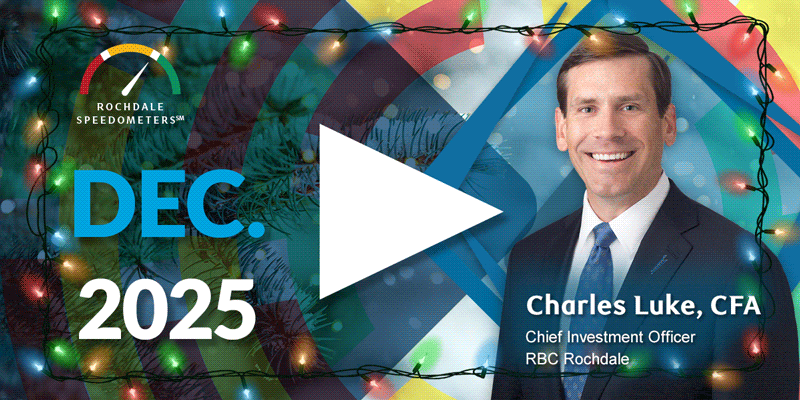-
Economic Perspectives
Still Waiting for that Recession
August 2023
- Filename
- Economic Perspectives AUGUST 2023.pdf
- Format
- application/pdf
TRANSCRIPT
For well over a year now, we've been hearing talk about a recession that's about to start, and for well over a year, we have not seen it. We've jokingly referred to it as "The Godot Recession" from the Samuel Beckett play – waiting for it to show up because it hasn't yet. But predicting when a recession starts is not an easy task.
That said, recent history has been relatively simple.
During COVID-19, when 21 million people lost their jobs in one month, it was obvious we were going into a recession. With the dot-com recession in 2001 and then the housing crisis recessions in 2007, it was easy to figure out a recession would be starting very soon, mainly because of the tremendous amount of wealth loss at the household level, and you can see that here in this first chart.
[ Chart 1: 1:03 ] In 2001, the S&P 500 docked 49%, and in 2007, stocks fell 57%.
[ Chart 2: 1:15 ] Add to that this next chart, where you can see home values fell 27% during the housing crisis. That loss of wealth quickly altered consumer behavior to reduce the pace of spending, and then it became a recession, but it's a little trickier to forecast our session now. This is because we haven't seen that massive loss of household wealth.
[ Charts 3 & 4: 1:33 ] Take a look at these same charts. The stock market is down 7% from the recent highs that we see in any normal year. That's nothing atypical. In terms of housing values, those are down 1% from their recent peak. In fact, the last four months, values are starting to move up. The fundamentals for housing are quite strong, along with the demographics. The fundamentals is there's just not enough homes for sale for the demand. The demographics are quite strong as young people, who did not buy homes during the period of time before the pandemic, now all of a sudden want them, so you don't have the tremendous amount of household wealth. What you have this time is a much trickier situation. Without that massive loss of household wealth, it's a lot trickier to forecast when the recession will start.
This has to do with the fact that we're only relying on the fact that the Federal Reserve Bank has been raising interest rates to slow down consumer demand to bring it back into alignment with supply so that the inflationary pressures will recede back to the Fed's target of 2%.
Adding to that, the Fed does not want to crank up interest rates too fast to pause the recession. Instead, they want to orchestrate what they call a "soft landing," which is a gradual slowdown of economic growth that avoids a recession but brings supply and demand back into alignment. That is always the Fed's goal for these sort of circumstances, but the thing is that they're not very successful at it.
[ Chart 5: 3:00 ] Take a look at this chart here. This shows the Federal Funds Rate going back to 1955. Again, the recessions are in the gray areas, you can see these three green circles. This is indicating when the Fed was able to raise interest rates to slow the economy, but not cause recession. Now take a look at these 10 red circles. This is when the Fed raised interest rates and a recession quickly followed. The plan of attack for the Fed is relatively simple: They raise interest rates enough to reduce demand. A feedback loop is established. With higher financing costs leading to reduced demand, this leads to layoffs, which reduces demand even further, causing even more job losses until the recession is reached.
The higher interest rates first impact consumer spending where financing is needed. Most notably, this takes place in the housing sector. Mortgage rates are now above 3%. That's a significant increase from the 3% level that we were seeing for a long period of time before the Fed started to raise interest rates, and this has impacted demand.
[ Chart 6: 4:06 ] In this chart here, we see the total amount of both new and existing home sales, which have fallen 31% since the Fed started to raise interest rates.
It's not as severe as what we saw a little over a decade ago where they fell 51%, but it's still a significant change in demand. What's interesting is that the number of construction workers has not declined, but it's actually increased.
[ Chart 7: 4:25 ] This is showing the number of people that are working in construction, which currently stands at almost 8 million, well above the long term average of 6.8 million workers.
[ Chart 8: 4:42 ] More important is the number of job openings. There's still demand for even more people to work in construction. As you can see here, it stands at 374,000 – that's about twice the long-term average. The demand for these workers is due to remodeling of homes and construction of warehouses due to the demand for domestic inventory. Businesses are moving to "just in case" inventory management and away from "just in time" management, where things would just show up when needed.
There's also demand from distribution centers from online shopping companies, and the building of manufacturing plants due to reshoring. There's also a fiscal stimulus from the CHIPS Act and the infrastructure build that's pushing up demand for even more construction workers.
This is not just with construction – we're seeing this in so many other industries. Whether it's manufacturing or medical care, the demand for workers continues to remain quite strong.
This delay in the expected date of the start of the recession can be attributed to the leftover effects from the pandemic and from the federal stimulus programs that are having a larger-than-anticipated multiplier effect and is making the economy less sensitive than usual to the business cycle dynamics of Fed tightening.
Add to that that household net worth is near all-time highs, household leverage is low, and the unemployment rate is hovering around 70-year lows. The demand to consume has not declined significantly yet, extending the start of that recession.
We believe this is starting to change. The 525 basis points of Fed tightening that we've seen in a little bit more than a year are starting to have an impact.
[ Chart 9: 6:30 ] In this final slide, you can see how loan demand has fallen off significantly as a result of higher interest rates, and the fact that banks are far more restrictive in their lending policies.
The dark blue columns you see here are showing the three-month percent change annualized. You can see that it's currently standing at just four-tenths of 1% – significantly less than the long-term average of 6.4% and much less than what we saw last year when lending was up around 12% on an annualized basis.
[ Summary: 7:30 ] This sharp drop-off in lending, we believe, will lead to much slower pace of spending by consumers, which is exactly what the Fed wants, so that it can bring inflationary pressures back under control.
Stay Informed.
Get our Insights delivered straight to your inbox.
Put our insights to work for you.
If you have a client with more than $1 million in investable assets and want to find out about the benefits of our intelligently personalized portfolio management, speak with an investment consultant near you today.
If you’re a high-net-worth client who's interested in adding an experienced investment manager to your financial team, learn more about working with us here.




